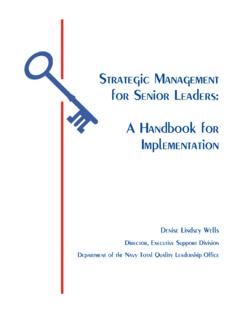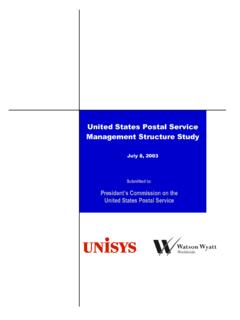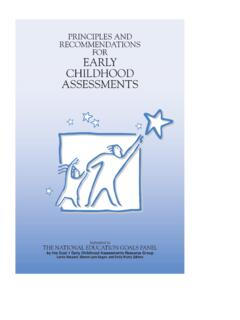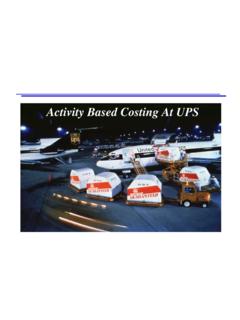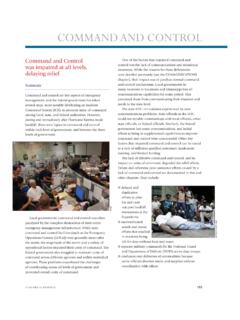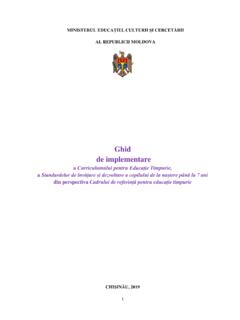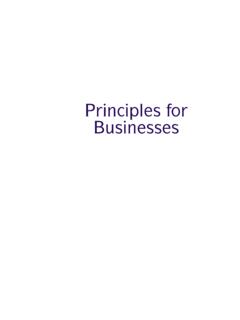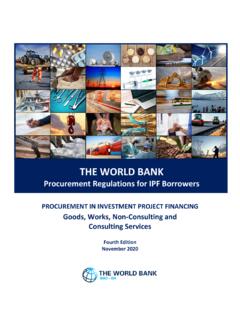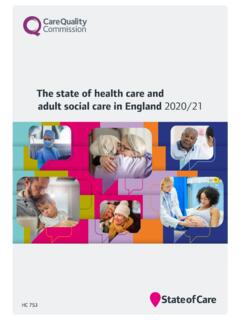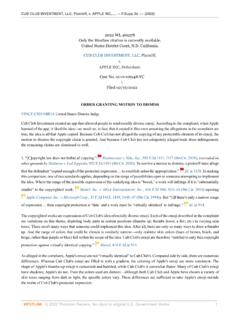Transcription of RECOMMENDATIONS FOR EARLY CHILDHOOD ASSESSMENTS
1 PRINCIPLES AND RECOMMENDATIONS FOREARLY CHILDHOOD ASSESSMENTSS ubmitted toTHE NATIONAL EDUCATION GOALS PANELby the Goal 1 EARLY CHILDHOOD ASSESSMENTS Resource GroupLorrie Shepard, Sharon Lynn Kagan, and Emily Wurtz, Editors 177 575 Prin/Rec1/16 2/18/98 2:13 PM Page C1 National Education Goals PanelGovernorsJames B. Hunt, Jr., North Carolina (Chair, 1997 1998)John Engler, MichiganWilliam Graves, KansasPaul E. Patton, KentuckyRoy Romer, Colorado Tommy G. Thompson, WisconsinCecil Underwood, West VirginiaChristine Todd Whitman, New JerseyMembers of the AdministrationCarol H. Rasco, Senior Advisor to the Secretary of EducationRichard W. Riley, Secretary of EducationMembers of Senator Jeff Bingaman, New Senator Jim Jeffords, Representative William F. Goodling, Representative Dale E.
2 Kildee, MichiganState LegislatorsRepresentative G. Spencer Coggs, WisconsinRepresentative Ronald Cowell, PennsylvaniaRepresentative Mary Lou Cowlishaw, IllinoisRepresentative Douglas R. Jones, IdahoNational Education Goals Panel StaffKen Nelson, Executive DirectorLeslie A. Lawrence, Senior Education AssociateCynthia D. Prince, Associate Director for Analysis and ReportingEmily O. Wurtz, Senior Education AssociateCynthia M. Dixon, Program AssistantJohn Masaitis, Executive OfficerSherry Price, SecretaryGoal 1 EARLY CHILDHOOD ASSESSMENTS Resource GroupLeaders:Sharon Lynn Kagan, Yale UniversityLorrie Shepard, University of ColoradoSue Bredekamp, National Association for the Education of Young ChildrenEdward Chittenden, Educational Testing ServiceHarriet Egertson, Nebraska State Department of EducationEugene Garc a, University of California, BerkeleyM.
3 Elizabeth Graue, University of WisconsinKenji Hakuta, Stanford UniversityCarollee Howes, University of California, Los AngelesAnnemarie Palincsar, University of MichiganTej Pandey, California State Department of EducationCatherine Snow, Harvard UniversityMaurice Sykes, District of Columbia Public SchoolsValora Washington, The Kellogg FoundationNicholas Zill, Westat, 1998 177 575 Prin/Rec1 2/24/98 4:11 PM Page C2 Goal 1: Ready to LearnBy the year 2000, all children in America will start school ready to :nAll children will have access to high-quality and developmentally appropriatepreschool programs that help prepare children for parent in the United States will be a child s first teacher and devote timeeach day to helping such parent s preschool child learn, and parents will haveaccess to the training and support parents will receive the nutrition, physical activity experiences, and healthcare needed to arrive at school with healthy minds and bodies, and to maintainthe mental alertness necessary to be prepared to learn, and the number of low-birthweight babies will be significantly reduced through enhanced prenatalhealth AND RECOMMENDATIONS FOR EARLY CHILDHOOD ASSESSMENTS 177 575 Prin/Rec1 2/24/98 4:11 PM Page 12 177 575 Prin/Rec1 2/24/98 4.
4 11 PM Page 2 Americans want and need good information on the well-being of youngchildren. Parents want to know if their children will be ready for and school administrators want to know if their programs are effectiveand if they are providing children the right programs and services. Policymakerswant to know which program policies and expenditures will help children andtheir families, and whether they are effective over time. Yet young children arenotoriously difficult to assess accurately, and well-intended testing efforts in thepast have done unintended harm. The principles and RECOMMENDATIONS in thisreport were developed by advisors to the National Education Goals Panel to helpearly CHILDHOOD professionals and policymakers meet their information needs byassessing young children appropriately and first National Education Goal set by President Bush and the nation sGovernors in 1990 was that by the year 2000, all children in America will startschool ready to learn.
5 This Goal was meant to help those advocating theimportance of children s needs. Yet from the start, Goal 1 proved problematic tomeasure. The Panel could find no good data or methods to measure children sstatus when they started school. In view of the importance of this issue, Congressin 1994 charged the Goals Panel to support its Goal l advisors to create clearguidelines regarding the nature, functions, and uses of EARLY CHILDHOOD ASSESSMENTS ,including assessment formats that are appropriate for use in culturally and linguisticallydiverse communities, based on model elements of school readiness. The principles andrecommendations in this document are the result of efforts by the Goal 1 EarlyChildhood ASSESSMENTS Resource Group to address this and the Unique Development of Young ChildrenAssessing children in the earliest years of life from birth to age 8 is difficultbecause it is the period when young children s rates of physical, motor, and linguisticdevelopment outpace growth rates at all other stages.
6 Growth is rapid, episodic, andhighly influenced by environmental supports: nurturing parents, quality caregiving,and the learning setting. 3 Introduction 177 575 Prin/Rec1 2/24/98 4:11 PM Page 3 Because young children learn in ways and at rates different from older childrenand adults, we must tailor our ASSESSMENTS accordingly. Because young childrencome to know things through doing as well as through listening, and because theyoften represent their knowledge better by showing than by talking or writing,paper-and-pencil tests are not adequate. Because young children do not have theexperience to understand what the goals of formal testing are, testing interactionsmay be very difficult or impossible to structure appropriately. Because youngchildren develop and learn so fast, tests given at one point in time may not give acomplete picture of learning.
7 And because young children s achievements at anypoint are the result of a complex mix of their ability to learn and past learningopportunities, it is a mistake to interpret measures of past learning as evidence ofwhat could be these reasons, how we assess young children and the principles that framesuch ASSESSMENTS need special attention. What works for older children or adultswill not work for younger children; they have unique needs that we, as adults, areobliged to recognize if we are to optimize their Assessment IssuesEducators and child development specialists have long recognized the uniqueness ofthe EARLY years. Informal assessment has characterized the EARLY CHILDHOOD field. Earlyeducators have observed and recorded children s behavior naturalistically, watchingchildren in their natural environments as youngsters carry out everyday observations have proven effective for purposes of chronicling children sdevelopment, cataloging their accomplishments, and tailoring programs andactivities within the classroom to meet young children s rapidly changing , however, there has been an increase in formal ASSESSMENTS and testing,the results of which are used to make high stakes decisions such as trackingyoungsters into high- and low-ability groups, (mis)labeling or retaining them, orusing test results to sort children into or out of kindergarten and preschools.
8 Inmany cases, the instruments developed for one purpose or even one age group ofchildren have been misapplied to other groups. As a result, schools have oftenidentified as not yet ready for kindergarten, or as too immature for groupsettings, large proportions of youngsters (often boys and non-English speakers) who would benefit enormously from the learning opportunities provided in thosesettings. In particular, because the alternative treatment is often inadequate,screening out has fostered inequities, widening and perpetuating the gapbetween youngsters deemed ready and 177 575 Prin/Rec1 2/24/98 4:11 PM Page 4 The Current ClimateDespite these difficulties, demands for ASSESSMENTS of student learning areincreasing. Pressed by demands for greater accountability and enhancededucational performance, states are developing standards for school-aged childrenand are creating new criteria and approaches for assessing the achievement ofchallenging academic goals.
9 In this context, calls to assess young children frombirth through the earliest grades in school are also increasing. This documentattempts to indicate how best to craft such ASSESSMENTS in light of young children sunique development, recent abuses of testing, and the legitimate demands fromparents and the public for clear and useful principles and RECOMMENDATIONS in this document are meant to help stateand local officials meet their information needs well. They indicate both generalprinciples and specific purposes for ASSESSMENTS , as well as the kinds of provisionsneeded to ensure that the results will be accurate and useful for those testing young children has in the past led to unfair or harmful effects, therecommendations include warnings to protect against potential misuse.
10 To explainthe basis of these RECOMMENDATIONS , there is a definition of each of four categoriesof assessment purpose, the audiences most concerned with the results of each, thetechnical requirements that each assessment must meet, and how assessmentconsiderations for each purpose vary across the age continuum from birth to 8years of age. General PrinciplesThe following general principles should guide both policies and practices for theassessment of young children. Assessment should bring about benefits for accurate information from young children is difficult and potentiallystressful. Formal ASSESSMENTS may also be costly and take resources that couldotherwise be spent directly on programs and services for young children. Towarrant conducting ASSESSMENTS , there must be a clear benefit either in directservices to the child or in improved quality of educational programs.
